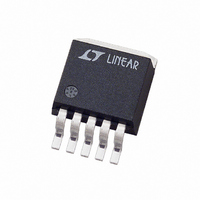LT3080EQ#TRPBF Linear Technology, LT3080EQ#TRPBF Datasheet - Page 12

LT3080EQ#TRPBF
Manufacturer Part Number
LT3080EQ#TRPBF
Description
IC REG LDO ADJ 1.1A 5-DDPAK
Manufacturer
Linear Technology
Datasheet
1.LT3080ESTTRPBF.pdf
(26 pages)
Specifications of LT3080EQ#TRPBF
Regulator Topology
Positive Adjustable
Voltage - Output
0 ~ 36 V
Voltage - Input
1.2 ~ 36 V
Voltage - Dropout (typical)
1.35V @ 1.1A
Number Of Regulators
1
Current - Output
1.1A
Current - Limit (min)
1.1A
Operating Temperature
-40°C ~ 125°C
Mounting Type
Surface Mount
Package / Case
TO-263-5, D²Pak (5 leads + Tab), TO-263BA
Lead Free Status / RoHS Status
Lead free / RoHS Compliant
Available stocks
Company
Part Number
Manufacturer
Quantity
Price
LT3080
from the error amplifi er must be considered, and the gain
created by using a resistor divider cannot be forgotten.
Traditional low noise regulators bring the voltage refer-
ence out to an external pin (usually through a large value
resistor) to allow for bypassing and noise reduction of
reference noise. The LT3080 does not use a traditional
voltage reference like other linear regulators, but instead
uses a reference current. That current operates with typi-
cal noise current levels of 3.2pA/√Hz (1nA
10Hz to 100kHz bandwidth). The voltage noise of this
is equal to the noise current multiplied by the resistor
value. The resistor generates spot noise equal to √4kTR
(k = Boltzmann’s constant, 1.38 • 10
absolute temperature) which is RMS summed with the
reference current noise. To lower reference noise, the
voltage setting resistor may be bypassed with a capacitor,
though this causes start-up time to increase as a factor
of the RC time constant.
The LT3080 uses a unity-gain follower from the SET pin
to drive the output, and there is no requirement to use
a resistor to set the output voltage. Use a high accuracy
voltage reference placed at the SET pin to remove the er-
rors in output voltage due to reference current tolerance
and resistor tolerance. Active driving of the SET pin is
acceptable; the limitations are the creativity and ingenuity
of the circuit designer.
One problem that a normal linear regulator sees with refer-
ence voltage noise is that noise is gained up along with the
output when using a resistor divider to operate at levels
higher than the normal reference voltage. With the LT3080,
the unity-gain follower presents no gain whatsoever from
the SET pin to the output, so noise fi gures do not increase
accordingly. Error amplifi er noise is typically 125nV/√Hz
(40μV
another factor that is RMS summed in to give a fi nal noise
fi gure for the regulator.
Curves in the Typical Performance Characteristics show
noise spectral density and peak-to-peak noise character-
istics for both the reference current and error amplifi er
over the 10Hz to 100kHz bandwidth.
Overload Recovery
Like many IC power regulators, the LT3080 has safe operat-
ing area (SOA) protection. The SOA protection decreases
APPLICATIONS INFORMATION
12
RMS
over the 10Hz to 100kHz bandwidth); this is
–23
J/°K, and T is
RMS
over the
current limit as the input-to-output voltage increases and
keeps the power dissipation at safe levels for all values
of input-to-output voltage. The LT3080 provides some
output current at all values of input-to-output voltage up
to the device breakdown. See the Current Limit curve in
the Typical Performance Characteristics.
When power is fi rst turned on, the input voltage rises and
the output follows the input, allowing the regulator to start
into very heavy loads. During start-up, as the input voltage
is rising, the input-to-output voltage differential is small,
allowing the regulator to supply large output currents.
With a high input voltage, a problem can occur wherein
removal of an output short will not allow the output volt-
age to recover. Other regulators, such as the LT1085 and
LT1764A, also exhibit this phenomenon so it is not unique
to the LT3080.
The problem occurs with a heavy output load when the
input voltage is high and the output voltage is low. Com-
mon situations are immediately after the removal of a
short circuit. The load line for such a load may intersect
the output current curve at two points. If this happens,
there are two stable operating points for the regulator.
With this double intersection, the input power supply may
need to be cycled down to zero and brought up again to
make the output recover.
Load Regulation
Because the LT3080 is a fl oating device (there is no ground
pin on the part, all quiescent and drive current is delivered
to the load), it is not possible to provide true remote load
sensing. Load regulation will be limited by the resistance
Figure 7. Connections for Best Load Regulation
V
CONTROL
IN
SET R
LT3080
+
–
SET
OUT
RESISTANCE
PARASITIC
R
R
R
P
P
P
3080 F07
LOAD
3080fb














